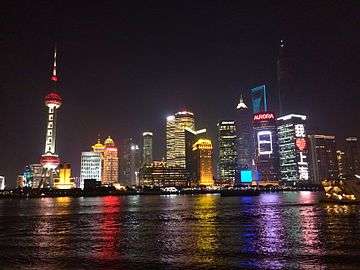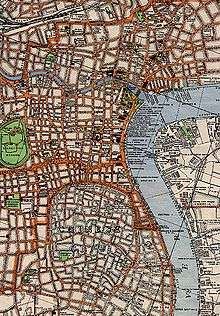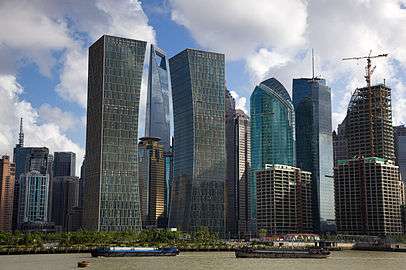Lujiazui



Lujiazui (simplified Chinese: 陆家嘴; traditional Chinese: 陸家嘴; pinyin: Lùjiāzuǐ, lit. meaning "Lu's mouth"), formerly known as Lokatse from its pronunciation in Shanghainese, is a locality in Shanghai, a peninsula formed by a bend in the Huangpu River. Since the early 1990s, Lujiazui has been developed specifically as a new financial district of Shanghai. The decision to earmark Lujiazui for this purpose reflects its location: it is located on the east side of the Huangpu River in Pudong, and sits directly across the river from the original financial and business district of the Bund.
Lujiazui is a national-level development zone designated by the government. In 2005, the State Council reaffirmed the positioning of the 31.78 km2 (12.27 sq mi) Lujiazui area as the only finance and trade zone among the 185 state-level development zones in mainland China.
Geography
Lujiazui is located in the Pudong New District on the eastern bank of Huangpu River. It forms a peninsula on a bend of the Huangpu River, which turns from flowing north to flowing east. The importance of Lujiazui stems from the fact that it lies directly across the river from the Bund, the old financial and business district of Shanghai, and just south of the confluence of the Suzhou Creek with the Huangpu River. Until the 1980s, Lujiazui was a relatively low-built area, featuring residential houses, warehouses, and factories. Following the allocation of Lujiazui as a special investment zone in 1992, the development of Lujiazui's skyline begun. This was largely driven by Chinese state owned enterprises investing and developing the property within the area, with the inaugural landmark, the Oriental Pearl Tower, being completed in 1994.
Economy
Currently, there are more than 30 buildings over 25 stories high with commerce as their leading function, and over 504 domestic and overseas financial and insurance corporations located in Lujiazui.[1]
The success of Lujiazui in the past 20 years has fueled tourism and business related travel to Shanghai. Pictures of the Lujiazui skyline dominate Shanghai tourism materials, and there are 5 five-star hotels in the area, providing approximately 2,443 rooms, and three more five-star hotels are expected in the area in the coming years, adding more than 1,200 luxury units.[2]
Landmark buildings
Landmark buildings in Lujiazui include:
- Oriental Pearl Tower
- Jin Mao Building
- Shanghai World Financial Center
- Super Brand Mall
- Aurora Plaza
- Shanghai IFC
- Bank of China Tower
- Shanghai Tower
Transportation
By water, Lujiazui is linked to the rest of central Shanghai by ferry services from two wharves, located at the northern and southern ends of the area respectively. At the southern end, the Dongchang Road ferry terminal provides river-crossing services across the Huangpu River to central and southern central Shanghai. The most popular ferry service for tourists connects Dongchang Road wharf with Jinling East wharf, located on the Bund. At the north end, the Xichang Inn wharf provides river-crossing services across the Huangpu River to northern central Shanghai. The former Lujiazui ferry wharf, once part of the most popular river crossing in Shanghai, was closed in 1999, with its wharf structure now used as a waterfront seating area.
By road, Lujiazui is connected to the rest of central Shanghai by the Yan'an East Road Tunnel, linking the southern end of the Bund with the centre of Lujiazui. Further away from the centre of Lujiazui, the Renmin Road Tunnel and Fuxing East Road Tunnel link southern Lujiazui with southern central Shanghai, while Xinjian Road Tunnel and Dalian Road Tunnel link northern Lujiazui with northern central Shanghai.
By metro, Lujiazui is served by Lujiazui station, which is on Shanghai Metro Line 2.
Additionally, the Bund Sightseeing Tunnel is a tourist attraction consisting of slow-moving underground vehicles which move between the Bund and Lujiazui accompanied by light and sound effects in the tunnel.
Gallery

 CITIC Pacific HQ & Mandarin Oriental
CITIC Pacific HQ & Mandarin Oriental- Lujiazui Finance and Trade Zone, Pudong
- Lujiazui skyline, Pudong
 Lujiazui panorama
Lujiazui panorama
Tallest Buildings 170m+
| Address
22 December 2014, 13:46:19 |
Alternative name | Image | Height(m) | Number of floors | Year of completion |
|---|---|---|---|---|---|
| 51 West Lujiazui Road | Shanghai Tower |  |
632 | 121 | 2014 |
| 100 Century Avenue | Shanghai World Financial Center |  |
492 | 101 | 2008 |
| 1 Century Avenue | Oriental Pearl Radio & TV Tower |  |
467.9 | 14 | 1994 |
| 88 Century Avenue | Jin Mao Tower | |
421 | 93 | 1998 |
| 68 Middle Yincheng Road | One Lujiazui |  |
269 | 53 | 2008 |
| 188 Middle Yincheng Road | BoCom Financial Towers |  |
265 | 52 | 2002 |
| 168 East Yincheng Road | Bank of Shanghai Headquarters |  |
252 | 46 | 2005 |
| 8 Century Avenue | Shanghai International Finance Centre South Tower | 250 | 58 | 2009 | |
| 200 Central Yincheng Road | Bank of China Tower |  |
226 | 53 | 2000 |
| 99 Fucheng Road | Aurora Plaza | |
185 | 37 | 2003 |
References
- ↑ Knight Frank China Knight Frank China, Shanghai District Overview - Pudong
- ↑ Knight Frank China Knight Frank China, Shanghai Annual Commercial Report 2009
External links
| Wikimedia Commons has media related to Pudong Lujiazui. |
- "Lujiazui still on the rise," by Tian Xiuzhen, Shanghai Star. 2004-12-16
- "Lujiazui to become top biz district," Shanghai Daily. 2006-09-14
- ShanghaiDaily.com - Area review.
Coordinates: 31°14′20″N 121°29′50″E / 31.23889°N 121.49722°E